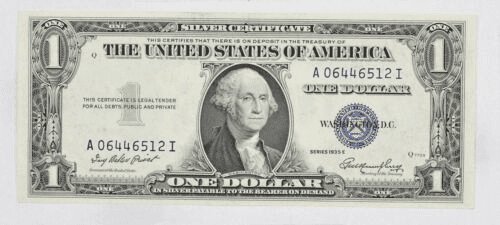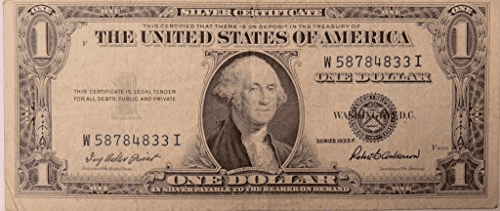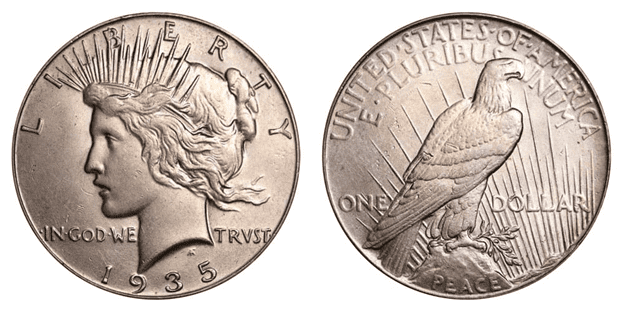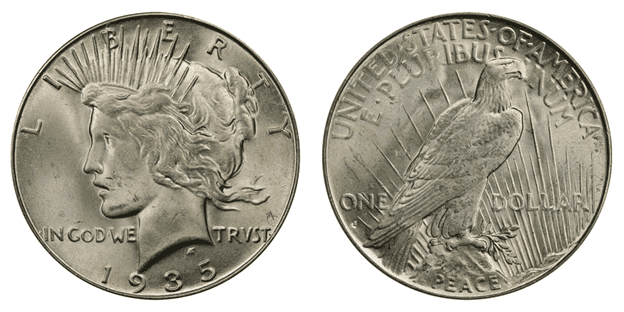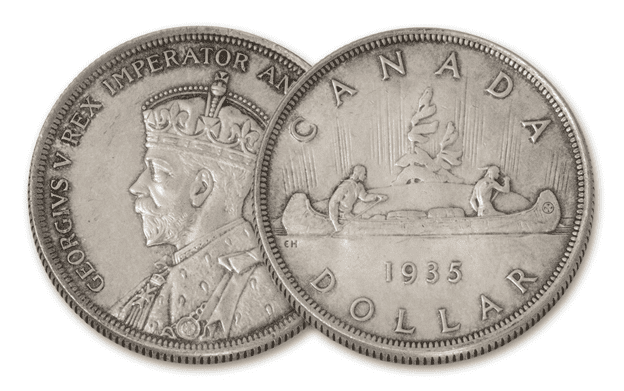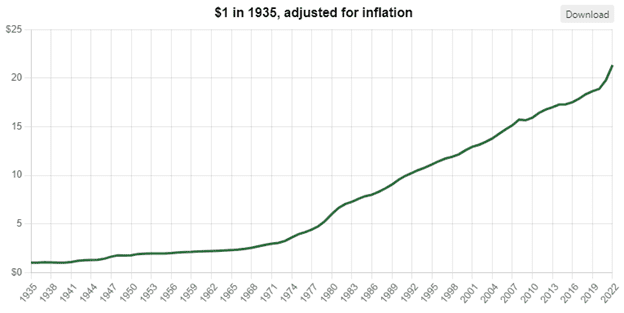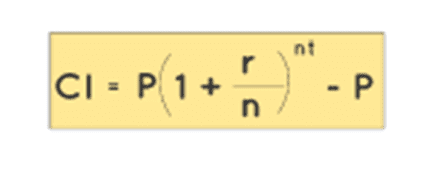What Does A 1935 Dollar Bill Look Like?
The $1 bill has an interesting history, despite the fact that some individuals are in favor of getting rid of it. From the “funnybacks” that first appeared in the 1920s to the web-printed notes of the 1990s, the design of the dollar has seen some noteworthy changes over time.
The dominating feature of the Dollar Bill is the first president of the United States George Washington. Unlike more modern notes, the distinctive green color was not utilized in these early modern notes, and instead, the note has a tan hue.
Known as ‘One Dollar Silver Certificates’ the dollar bill represented the value of the silver one-dollar coin, known as the peace dollar, with the added benefit that it was much lighter and easier to carry around, not to mention cheaper to produce.
Although the 1935 one-dollar silver certificates are widespread, there are several seal designs and variants that can be valued.
There are three types of seals: blue, brown, and yellow. 1935, 1935A, 1935B, 1935C, 1935D, 1935E, 1935F, 1935G, and 1935H are a few of the several series.
The red R and red S experimental notes, the brown seal Hawaii notes, and the yellow seal North Africa notes are a few other uncommon variants; but more on this later.
The dollar bill has changed many times over the years and 1935 was no exception. Henry A. Wallace, Franklin D. Roosevelt’s agriculture secretary and ultimately vice president, proposed the addition of the Great Seal, with its distinctive pyramid and eagle features, to the $1 bill in 1935.
The nation’s Founding Fathers created the seal. A committee comprised of John Adams, Thomas Jefferson, and Benjamin Franklin was established to create a seal that would represent the aspirations of the new nation before the Continental Congress was dissolved on July 4, 1776.
However, Congress didn’t accept the final design until five years later. Charles Thomson, a prominent Philadelphian businessman and the Continental Congress’s secretary at the time, is credited with creating the seal.
The one-dollar bill’s appearance underwent another revision in 1935. The grey numeral to the right was deleted, the grey numeral to the left was shrunk, the Treasury seal was shrunk and Washington, D.C. was overlaid, and a stylized dollar was inserted over the treasury seal.
With the exception of the lack of in god we trust, the reverse was also modified to its current layout. The slogan “In God, We Trust” didn’t get added to the back of a dollar bill until 1957.
Since 1963, the dollar bill’s general appearance hasn’t changed much.
In addition to the first technicolor Mickey Mouse short film being made, Amelia Earhart undertakes a solo journey across the Pacific in 1935. Boulder (Hoover) Dam is now complete. The Neutrality Act, which prohibits the sale of military material to adversarial nations, is passed by US President FDR, and the China Clipper carries the first piece of airmail over the Pacific.
What Are 1935 Silver Dollars Worth?
From 1921 to 1928, as well as in 1934 and 1935 once more, peace silver dollars were in circulation. Combining the coins produced at the Philadelphia and San Francisco mints, approximately 3.6 million Peace silver dollars were produced in 1935.
A competition to develop a design that would symbolize peace produced Anthony de Francisci’s Peace silver dollar denomination, which includes the image of Liberty wearing a radiating crown.
A perched bald eagle and the sun’s rays are shown on the back of the 1935 Peace silver dollar. Directly beneath the eagle is the word “PEACE.”
90% silver and 10% copper make up a Peace silver dollar from 1935. This coin weighs 26.73 g and measures 38.1 mm in diameter. The 1921–1935 Peace silver dollars have reeded edges and a 2.4 mm thickness.
Silver is worth $25.64 per ounce as of April 2022. As a result, the 1935 silver dollar’s melt value, or minimum value, which is determined by taking into account the coin’s entire silver weight, is $19.83.
In uncirculated condition, the silver peace dollar can be worth between $60 and $110 dollars.
What Are The Rare Varieties of 1935 Dollar?
1935 Dollar Bill with Blue Seal

photo source: ebay
A used series 1935E $1 silver certificate (Blue Seal) costs around $2.90.
Yellow, blue, and brown are the three main hues of seals used in the Dollar Bills printed in 1935 and are marked as A through H. In North Africa, The U.S. military got $1 bills with a yellow seal and darker paper during World War II.
In response to the attack on Pearl Harbor, 1935A Hawaii $1 notes bearing a brown seal and the phrase Hawaii printed on the left side were printed.
1935 $1 Silver Certificate

photo source: jewelsadvisor.com
The 1935 series is quite prevalent and will only sell for their $1 face value in circulated conditions. Uncirculated value: $12.50 to $17.50. These bills only retail for roughly $3.50 in very good condition.
1935 Liberty Silver Dollar

photo source: somethingborrowedpdx.com
Only two minting facilities produced the 1935 Peace silver dollar pieces. There is no mint mark on the coins produced at the Philadelphia Mint, which is the primary US mint. The Philadelphia Mint produced around 1,576,000 1935 Peace silver coins.
Truthfully, because of their large mintage, 1935 Peace Silver Dollars cannot be considered rare coins, despite the fact that their silver content gives them intrinsic metal value.
1935 S Peace Dollar

photo source: www.usacoinbook.com
Unexpectedly, the San Francisco mint produced more peace silver dollars in 1935 than the Philadelphia mint did. The San Francisco mint produced a total of 1,964,000 1935 peace silver dollars.
Two reverse variations of the 1935-S were produced, each with three or four sun rays directly below the word “ONE.” Due to their increased scarcity and potential higher demand, four-rayed coins may be more expensive than three-rayed coins.
1935 Canadian Silver Dollar

photo source: www.govmint.com
The history of the first silver dollar in circulation in Canada is unmatched in numismatics. King George V’s Silver Jubilee, or his 25th year as king, was commemorated by the commissioning of the Voyageur Dollar, which was first struck in 1935.
In honor of the fur trade, the country’s founding industry, the coin’s name comes from the iconic image of two voyageurs—one a fur merchant and the other a Native Canadian—managing a canoe over open water.
One of the most well-known coin designs ever produced in Canada, the coin’s motif evoked the wide, untamed frontier of the country. Emanuel Hahn, a Canadian sculptor and artist, came up with the design, which endured for more than 50 years.
What Is The Buying Power Of $1 In 1935?
In terms of purchasing power, $1 in 1935 is comparable to around $21.34 in the present, a rise of $20.34 over 87 years. Between 1935 and the present, the dollar had average annual inflation of 3.58 per cent, resulting in a total price increase of 2,033.55 per cent.
According to the Bureau of Labor Statistics consumer price index, this indicates that current prices are 21.34 times higher than average prices since 1935. Only 4.686 per cent of everything a dollar could buy then is still available today.
The inflation rate in 1935 was 2.24%. 8.58 per cent has been added to the inflation rate since last year. If this figure remains true, $1 will have the same purchasing power as $1.09 in one year.
You could get a lot more for your money in 1930. For instance, the cost of a five-pound bag of sugar has decreased to just 25 cents.
Four bags of sugar for $1 could have made a lot of cookies, cakes, candies, and other delightful treats for our 1930s shopper.
In addition to the sugar, the following things are also available for one dollar:
- $3.11 for three pounds of butter.
- A dozen eggs cost $1.08.
- 20 grapefruits are equal to $1.
- Four pounds of sliced Sunnyfield bacon cost $1.
How To Calculate Inflation Rate Of Dollar (Since 1935)?
Inflation Graph or Timeline in the U.S. for $1

photo source: www.in2013dollars.com
Inflation graphs are a great way to visualize the inflation rate of the dollar from 1935 to the present. As you can see by the above graph, inflation was relatively slow and steady between 1935 and 1968, before starting to increase more rapidly from 1971-77 and spiking between 1977 and 1980.
Things then from a more consistent yet accelerate increase until we reach 2019-2022 when inflation spikes once again.
Using inflation calculator
An inflation calculator can give us more detailed information regarding the rate of inflation between 1935 and now. For example, $100 back in 1935 would be worth a whopping $1938 today, a total increase of 1,838.25%!
Using CPI Formula
‘CPI’ refers to ‘consumer price index’. The Consumer Price Index (CPI) tracks changes in consumer spending on a representative basket of goods and services across time.
Business owners can use CPI figures to set prices for their products while considering what consumers would pay given the state of the economy and what rivals are charging for similar things.
Analysts can spot periods of inflation and deflation by using the CPI calculation.
The consumer price index formula is:
Cost of products or services in a current period/cost of products or services in a previous time period x 100 = consumer price index
Using the Compound Interest Formula
Compound interest is interest that builds up over a set length of time on both principal and interest. The principal is also used to account for the interest that has accrued on a principal over time.
Additionally, the accumulated principal value is used to calculate interest for the subsequent time period.
The new way of calculating interest now utilized in all international financial and commercial operations is known as compound interest. When we look at the compound interest values that have built over successive time periods, the power of compounding is clearly apparent.
Put simply:
Compound Interest = Interest on Principal + Compounded Interest at Regular Intervals
Following the computation of the total amount over a period of time using the initial principal and the interest rate, the compound interest is determined.
The formula for calculating the amount is given below for an initial principal of P, an annual interest rate of r, a time period of t in years, and a frequency of n times the interest is compounded annually.

photo source: www.cuemath.com
How Does The Grading System Work?
The Sheldon Scale is used by numismatists to provide a numerical value to coins. The Sheldon Scale goes from poor (P-1) to perfect mint state (P-1) (MS-70). Coins were originally evaluated using words to reflect their condition (Good, Fair, Excellent, Etc.). Unfortunately, coin collectors and dealers had different ideas about what each of these terms represent.
Professional numismatists joined together in the 1970s and established CoinGrading standards. These numismatists now assign grades at key places on the seventy-point scale, using the most regularly utilized numeric points in conjunction with the original adjective grade. The following are the most common coin grades:
-
-
- (P-1) Poor – Indistinguishable and probably damaged; if used, must have a date and mintmark; otherwise, rather battered.
- (FR-2) Fair – Nearly smooth, but without the damage that a coin graded Poor often possesses. The coin must have enough detail to be identified.
- (G-4) Fair – Inscriptions have merged into the rims in some areas, and important elements have been mostly erased.
- (VG-8) Very Good- A little weathered, but all of the primary design elements are visible, albeit faintly. There is little if any, central detail left.
- (F-12) Good – The item is very worn, yet the wear is even, and the overall design details stand out clearly. Rims are almost completely isolated from the field.
- (VF-20) Very Fine – Moderately weathered, with some finer features still visible. The motto or all letters of LIBERTY are readable. Both sides of the coin have entire rims that are separated from the field.
- (EF-40) Extremely Fine – Gently used; all gadgets are visible, and the most important ones are bold. The finer details are bold and clear, however, light wear may be seen.
- (AU-50) Uncirculated – Slight evidence of wear on the coin’s design’s high points; may have contact marks; eye appeal should be adequate.
- (AU-58) Uncirculated Choice – Slight traces of wear, no severe contact marks, almost full mint shine, and great eye appeal.
- (MS-60) Mint State Basal – Strictly uncirculated; no indication of wear on the coin’s highest points, but an unsightly coin with reduced luster, visible contact marks, hairlines, and other flaws.
- (MS-63) Mint State Acceptable – Uncirculated, but with contact scratches and nicks, little reduced shine, but otherwise appealing appearance. The strike is weak to average.
- (MS-65) Mint State Choice – Uncirculated with great mint shine, very little contact blemishes, and exceptional eye appeal. The strike is unusually severe.
- (MS-68) Mint State Premium Quality – Uncirculated with superb luster, no obvious contact marks to the naked eye, and exceptional eye appeal. The strike is quick and appealing.
- (MS-69) Almost Perfect Mint State – Uncirculated with perfect brilliance, a sharp and appealing strike, and extremely good eye appeal. A near-perfect coin with minor imperfections in the planchet, strike, and contact markings (seen only under 8x magnification).
- (MS-70) Mint State Perfect – Under 8x magnification, there are no tiny imperfections discernible; the strike is crisp, and the coin is perfectly centered on a beautiful planchet. Rarely seen on a coin, this coin is bright and whole, with original luster and exceptional eye appeal.
-
Where To Buy Or Sell 1935 Dollars?
When it comes to buying and selling 1935 Dollars, your options vary depending on whether you’re looking to buy or sell a Dollar Coin or a Dollar Bill, as despite both being currency are viewed very differently by the numismatic society.
Due to their silver content 1935 Peace Dollars, carry intrinsic metal value despite any issues with condition, and could be bought and sold by a silver dealer or pawn broker.
Rarer or high-quality examples should always be sold and graded through professional services such as online auction houses and services such as PCGS.
Silver peace dollars can also be bought with confidence through Bullion services. Paper notes can also be bought and sold through online currency specialist sites, and can also be found on eBay and Etsy, making them a great starting point for an entry-level collector.
FAQs
[H3] What does a blue seal on a dollar bill mean?
Yellow, blue, and brown are the three main hues of seals used in the Dollar Bills printed in 1935, of these hues, blue is the most common example.
[H3] What does “silver certificate’ mean on a dollar bill?
Legal tender in the form of paper money is referred to as a “Silver Certificate.” The certificate can now be exchanged for its face value instead of its original redemption value of silver, but the term still stays present on dollar bills as a nod to its history.
[H3] How much does a 1935 silver dollar weigh?
A 1935 Peace silver dollar comprises 90% silver and 10% copper. The coin weighs 26.73 gm, with 0.77344 troy oz of silver.
[H3] What year silver dollar is worth the most?
The first silver dollar ever minted by the United States is thought to be a 1794 Flowing Hair, which is considered to be the “holy grail” of all silver dollars. In 2013, numismatist and coin dealer Bruce Morelan paid $10 million for this absurdly rare coin.

